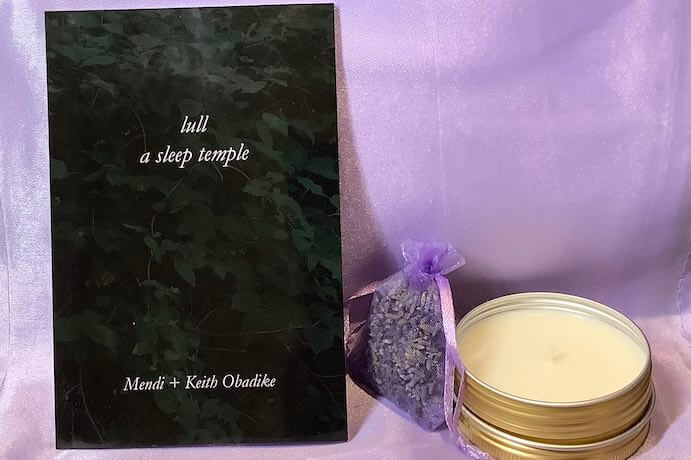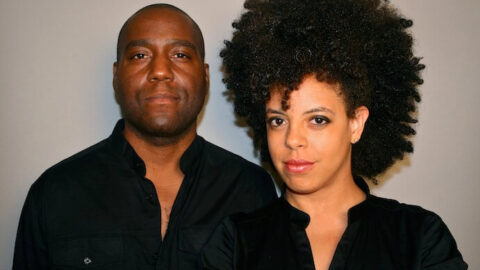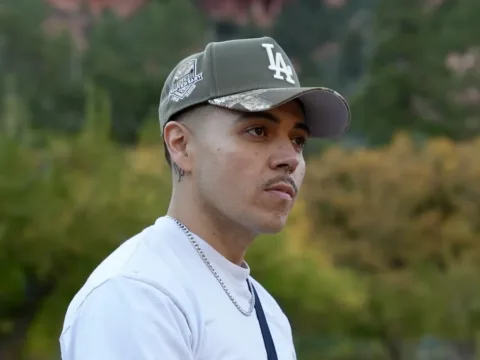For the 2021 edition of the Look + Listen Festival, four multimedia artists created work to be experienced in a cozy and familiar venue: your very own home. Husband-and-wife team Mendi + Keith Obadike created an overnight musical work called lull, a sleep temple for the festival. This 8-hour livestream event is a sonic environment meant to accompany sleep, and features elements such as distended melodies, field recordings, analog synths, and original texts incanted by Mendi. lull will have streaming performances on May 8, 15, and 29 (registration is currently full, but more tickets will be released on Monday, May 3rd). Performance times vary, so be sure to check which date works with your sleep schedule. Each stream will be preceded by a live chat with its creators. The first 100 registrants will receive a sleep kit in the mail, which includes a bedtime poem, sachet of lavender, and candle made by the artists.
What drew you to create a work to be listened to while sleeping?
We, like many artists, often find ourselves making what we need from the world. In the past, we have made pieces using text that we wanted to hear set to music or resonating a site that we wanted to hear sounded. In this case, we wanted a sleep piece for ourselves, so we decided to make it with the hope that other people would want to experience something like this, too. Our title, lull, a sleep temple, points both to a need for a pause, and to “sleep temples,” which are places to rest or dream. Historically, sleep temples were sites in ancient Egypt where people went and entered a sleep-like state for healing and dreaming. In our cultures (Igbo and African-American) dreams are still understood as extremely important. Sleeping and dreaming are understood as a way to connect to something larger than our conscious minds.
It is no coincidence that when articulating a vision for a better world, MLK said, “I have a dream,” a phrase he borrowed from Prathia Hall. Maya Angelou famously referred to herself in Still I Rise as the “…dream of the slave.” Marcus Garvey also talked about his early vision of himself as a leader and that of a future African Empire as a dream. The concept of imagining the world we want to create is connected to the activity of the relaxed and restored mind. We made lull while global political protests were happening in the name of BLM and the pandemic was raging. The common media euphemism for moments of political uprisings is a “period of unrest.” We have never liked that term “unrest” as a replacement for revolution, and we have recently felt the urgent need for rest. We have also specifically felt the need for dreaming, in order to realize personal and social transformation.
We should add that we have been interested in sounds, language, and music used to induce altered states of consciousness for many years. The music of the late 60s to late 70s that is sometimes called “energy music” or “spiritual jazz,” whose most notable practitioners are John and Alice Coltrane and Pharoah Sanders, has been some of the most important music to us. Much of this music grew out of the musicians’ explorations of other states of consciousness. While our practice does not sound like that music from the 70s, that music (which focused on sonic exploration and altered states) expanded our ideas about what could be done and certainly laid the groundwork for other related forms that were later called new age music, ambient music, and sound art. We have spent a lot of time looking at musical forms related to trance, hypnotic scripts, and sleep-related musical practices from around the world. These kinds of things have influenced past projects, but this is the first time that we have made a piece that we would truly describe as a sleep piece.

What was the process of developing the sound palette for lull like?
Most of the sounds are built from live instruments (a mix of acoustic and electro-acoustic), a couple of analog synths (an old Juno 106 and little Moog 32), and of course, vocals. We start by simply recording many multi-tracked pieces, layering guitars, piano, Rhodes, bass, and vocal harmonies. In some cases we are combining a recording of bowing our double bass with our performance on cello from an orchestral kit or a banjo doubling a violin line. We also have many of our own archival recordings of Keith multitracking phrases and songs to 24 inch analog tape. Those pieces provide a lot of warmth to the overall project. We are stretching out these recordings to make these drifting clouds of sound. Harmonically, we found the need to stay simple and triadic with the occasional minor nine to keep things interesting when blurring sounds in this way. The ideas are composed in chunks that are later assembled into the larger piece. We then go back and perform over large sections together in a dub-like fashion with some vocal and processing choices being made in real-time. So, essentially, there are layers of composed and improvised performances recorded to different media that make up the piece, with a lot of work on the overall textures, but we hope the final work feels much simpler than that.
Can you tell us about the texts and other multimedia materials you incorporate into the piece?
Our texts are mainly original writing by Mendi, but she has also incorporated her rewritings of some ancient myths involving dreams and fragments of language from historical texts on dream interpretation.
In our “dream kit,” which will be mailed out to early subscribers, we included a small bedtime poem with beautiful illustrations by David Brame. The bedtime poem appears in our music, as well. The “dream kit” also includes a small sachet of lavender and a small handmade lavender candle that we made in our studio.

Did creating work for a sleeping audience impact your compositional approach?
Well, yes. We were thinking a lot about both making something that would work for a sleeping audience in terms of dynamics, dissonances, repetitions, themes, and pacing, but it would also need enough of a musical arc and narrative detail to sustain engagement from awake listeners. We stretch melodic phrases out over several minutes with the hope that listeners feel an accruing melody without the kind of conscious melodic listening we might do over a much shorter span.
While the stories vary in style and tone, we approach the narrative with various forms of repetition. One section of the piece (with bowed piano and vocals about 16 minutes in), for example, is built around the repeated idea of seeing oneself in dreams we found in an ancient book from 1275 BC on dream interpretation. Another is a retelling of an ancient story from around 1401 BC about a dream, but in our version, each moment is restated several times with slight shifts in language before moving on to the next moment. We intend for these approaches to rhythm and narrative to speak to both sleeping and awake listeners. We spent a lot of time thinking about what stage of sleep the sleeper might be in at a given point in the night and what music or text should accompany that state.

You have such an incredible and diverse body of work! What do you recommend we check out in anticipation of lull?
Thank you. Many of our most recent music/video works are in conversation with lull. Our piece The Sun, is a meditation on visionaries and an Igbo proverb about the sun. Lift (Listening Skies) is a reflection on both the history of aerial photography and the one hundred year old song often called the Black National Anthem entitled “Lift Every Voice and Sing.” Book of Light is a sound and light show about the concept of internal light in science and mythology. The best place to learn more about these and other works is on our website, Obadike.com.
I CARE IF YOU LISTEN is an editorially-independent program of the American Composers Forum, funded with generous donor and institutional support. Opinions expressed are solely those of the author and may not represent the views of ICIYL or ACF.
A gift to ACF helps support the work of ICIYL. For more on ACF, visit the “At ACF” section or composersforum.org.
























